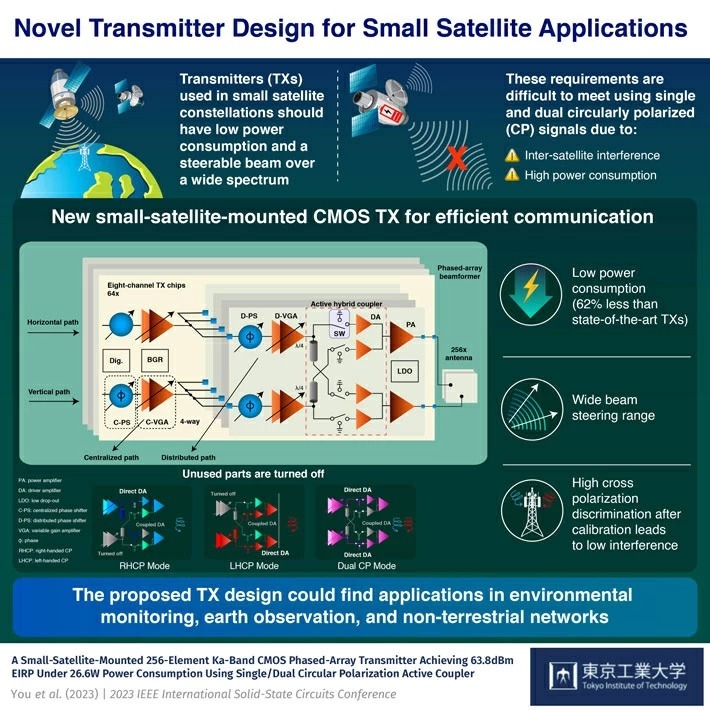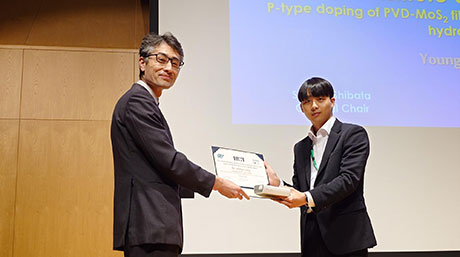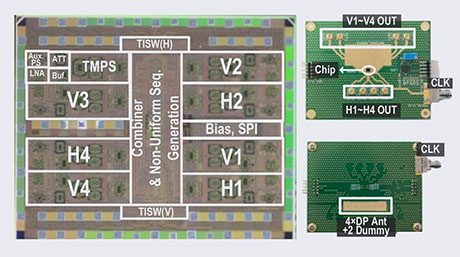Electrical and Electronic Engineering News
New Transmitter Design for Small Satellite Constellations Improves Signal Transmission
A novel transmitter design proposed in a recent study could solve some of the challenges related to signal transmission in small satellite constellations used for space applications. Developed by Tokyo Tech researchers, the new transmitter offers low power consumption along with excellent beam steering capabilities with high-speed communication, and can be designed using standard manufacturing technology.

Today, there are many emerging applications for small satellite constellations, ranging from space-borne networks to environmental monitoring. However, small satellites have special needs when it comes to transmitter (TX) technology. For one, they have stringent limitations on power consumption as they draw energy from solar panels and cannot easily dissipate generated heat. Moreover, small satellites need to communicate with fast-moving targets that can be over a thousand kilometers away. Thus, they require efficient and precise beam steering capabilities to direct most of the transmitted power towards the receiver.
On top of this, small satellite TXs have to generate different types of circularly polarized (CP) signals depending on the situation. Put simply, they need to faithfully generate both left-handed and right-handed CP signals to avoid interference with another transmitted signal with the opposite handedness. Additionally, they sometimes need to generate dual CP signals to establish high-speed data links.
Satisfying all these requirements simultaneously has proven to be challenging, especially when TXs are meant to operate with high-speed communication. Fortunately, a research team from Japan led by Associate Professor Atsushi Shirane from Tokyo Institute of Technology (Tokyo Tech), have been working on a convincing solution. Their latest paper, which will be presented at the 2023 IEEE International Solid-State Circuits Conference![]() , describes an innovative TX design that solves all the above-mentioned issues, paving the way for better small satellite-based communications.
, describes an innovative TX design that solves all the above-mentioned issues, paving the way for better small satellite-based communications.
The proposed TX operates from 25.5 GHz to 27 GHz in the Ka-band used for next-generation high-speed satellite communications. Its beam steering capabilities are governed by a 256-element active phased-array configuration. Put simply, the TX drives 256 tiny antennas that all emit the same signal but with carefully calculated phase delays between them. This enables precise steering of the output beam power by leveraging constructive and destructive interference between signals.
The signal to be transmitted to each antenna originally comes as two independent linear components, whereupon the proposed TX integrated circuit (IC) converts these two signals into a CP signal with the required phase delay. Since each TX IC has both centralized and distributed paths for the input signals, one can calibrate the signal phase and amplitude to vastly improve the intelligibility between left- and right-handed CP signals independently of beam steering calibrations.
However, the most important feature of this TX design is the use of an active hybrid coupler to select the CP transmission mode. The generation of left, right, and dual CP signals involves various elements on the IC, including amplifiers and phase shifters. The active hybrid coupler can "alter" the layout of the IC in real time, shutting off components that are not required in the desired transmission mode, saving power in the process.
The team tested various performance metrics of the proposed TX, and the results were promising. "Our TX achieved 63.8 dBm of equivalent isotropically radiated power with a power consumption of 26.6 W, which is a 62% reduction compared to the state-of-the-art TX with the same level of equivalent power," highlights Shirane.
To top it off, this small TX can be developed using standard manufacturing technology. "The proposed phased-array chip is fabricated in a 65 nm bulk CMOS process in a wafer-level chip-scale package with a die size of only 4.4 mm × 2.5 mm," he remarks.
With any luck, the study will help us reap the benefits of small satellite-based communication sooner!
- Reference
| Authors : | Dongwon You1, Xi Fu1, Xiaolin Wang1, Yuan Gao1, Wenqian Wang1, Jun Sakamaki1, Hans Herdian1, Sena Kato1, Michihiro Ide1, Yuncheng Zhang1, Ashbir Aviat fadila1, Zheng Li1, Chun Wang1, Yun Wang1, Jumpei Sudo2, Makoto Higaki2, Nahoka Kawaguchi2, Masaya Nitta2, Soichiro Inoue2, Takashi Eishima2, Takashi Tomura1, Jian Pang1, Hiroyuki Sakai1, Kenichi Okada1, and Atsushi Shirane1 |
| Title : | A Small-Satellite-Mounted 256-Element Ka-Band CMOS Phased-Array Transmitter Achieving 63.8dBm EIRP Under 26.6W Power Consumption Using Single/Dual Circular Polarization Active Coupler |
| Conference : | 2023 IEEE International Solid-State Circuits Conference |
| DOI : | N/A |
| Affiliations : |
1 Tokyo Institute of Technology, Tokyo, Japan 2 Axelspace |
|
* Corresponding author's email: shirane@ee.e.titech.ac.jp |
|
- Improving the Performance of Satellites in Low Earth Orbit | Tokyo Tech News
- Novel Architecture Can Reduce Noise-Induced Jitters in Digital Technology | Tokyo Tech News
- New and Improved Multi-Band Operational Receiver for 5G New Radio Communication | Tokyo Tech News
- Efficient Satellite Downlink with a Ka Band Dual Circular Polarization Transmitter | Tokyo Tech News
- Electricity and Data Over-the-Air: The Simultaneous Transmission of 5G and Power | Tokyo Tech News
- Introducing a Transceiver that Can Tap into the Higher Frequency Bands of 5G Networks | Tokyo Tech News
- Lean and mean: Maximizing 5G communications with an energy-efficient relay network | Tokyo Tech News
- Pushed to the Limit: A CMOS-based transceiver for beyond 5G applications at 300 GHz | Tokyo Tech News
- Greater Connectedness in Remote Areas: A Ka-band Transceiver for Satellite Communications | Tokyo Tech News
- Smallest all-digital circuit opens doors to 5 nm next-gen semiconductor | Tokyo Tech News
- A more accurate, low-cost 39 GHz beamforming transceiver for 5G communications | Tokyo Tech News
- Gearing up for 5G: A miniature, low-cost transceiver for fast, reliable communications | Tokyo Tech News
- Tinier and less power-hungry quantum atomic clock push toward intelligent IoT | Tokyo Tech News
- Shirane Lab.
- Okada Lab.
- Atsushi Shirane | Researcher Finder - Tokyo Tech STAR Search
- Kenichi Okada | Researcher Finder - Tokyo Tech STAR Search
- Takashi Tomura | Researcher Finder - Tokyo Tech STAR Search
- Laboratory for Future Interdisciplinary Research of Science and Technology (FIRST)
- Institute for Innovation Research (IIR)
- Electrical and Electronic Engineering Graduate Major|Education|Department of Electrical and Electronic Engineering, School of Engineering
- Electrical and Electronic Engineering Undergraduate Major|Education|Department of Electrical and Electronic Engineering, School of Engineering
- Axelspace
- Latest Research News
School of Engineering
—Creating New Industries and Advancing Civilization—
Information on School of Engineering inaugurated in April 2016
Further Information
Associate Professor Atsushi Shirane
Institute of Innovative Research,
Tokyo Institute of Technology






